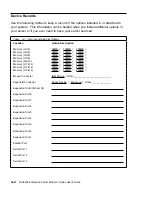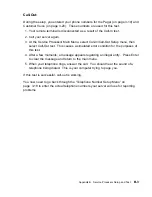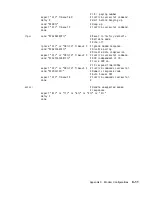
The server's operating system will have some built-in terminal emulators. You may
also have a commercially available terminal emulation. It is important that the local
and host computers select the same or compatible terminal emulators so the key
assignments and responses will match. This will assure successful communications
and control.
For best formatting, choose line wrap in your terminal emulator setup.
Recovery Procedures
Line noises, power surges, etc., can sometimes cause your modem to enter an
undefined state. When it is being used for dial-in, dial-out or ring indicate power-on,
your modem is initialized each time one of these actions is expected. If one of these
environmental conditions occur after your modem has been initialized, it may be nec-
essary to recover your modem to a known state.
If your modem communicates properly with remote users, it is probably in control. It
may be wise to occasionally change some of the functional settings and then change
them back, just for the sense of security that the modem is communicating, and to
assure it has been initialized recently.
Another strategy, particularly if your system is difficult to access physically, is to
protect it with an Uninterruptable Power Source (UPS) and a phone-line surge pro-
tector.
In case recovery becomes necessary, your system should be shut down as grace-
fully as possible. Disconnect the power cable and press the power button to drain
capacitance while power is disconnected. Disconnect and reconnect modem power,
then reconnect system power to allow complete reinitialization of your system.
Seamless Transfer of a Modem Session
There are about as many modem command variations as there are modems. The
sample modem configuration files have been written to capture the largest number of
workable modem settings.
The modem command &Dn (where 'n' is a number) generally sets the modem
response to the Data Terminal Ready (DTR) signal from the server's serial port. The
desired response is that the modem will hold a connection while DTR is enabled,
and drop the connection when DTR is released. This is the mechanism by which the
server hangs up on a connection under normal conditions.
C-6
RS/6000 Enterprise Server Model H Series User's Guide
Summary of Contents for H SERIES RS/6000
Page 1: ...RS 6000 Enterprise Server Model H Series IBM User s Guide SA38 0546 01...
Page 14: ...xiv RS 6000 Enterprise Server Model H Series User s Guide...
Page 16: ...xvi RS 6000 Enterprise Server Model H Series User s Guide...
Page 128: ...5 16 RS 6000 Enterprise Server Model H Series User s Guide...
Page 147: ...Chapter 6 Using the Online and Standalone Diagnostics 6 19...
Page 160: ...6 32 RS 6000 Enterprise Server Model H Series User s Guide...
Page 265: ...expect 8 r or 7 r or 6 r or 4 r or 3 r delay 2 done Appendix C Modem Configurations C 21...
Page 272: ...C 28 RS 6000 Enterprise Server Model H Series User s Guide...
Page 276: ...D 4 RS 6000 Enterprise Server Model H Series User s Guide...
Page 285: ...Index X 9...
Page 286: ...X 10 RS 6000 Enterprise Server Model H Series User s Guide...
Page 289: ......
















































